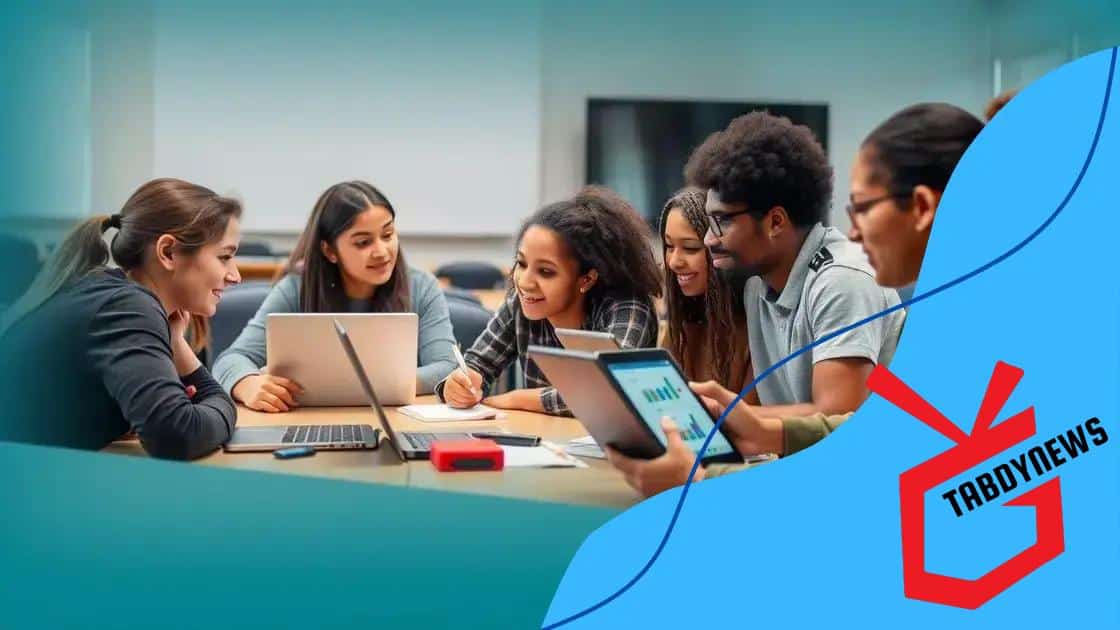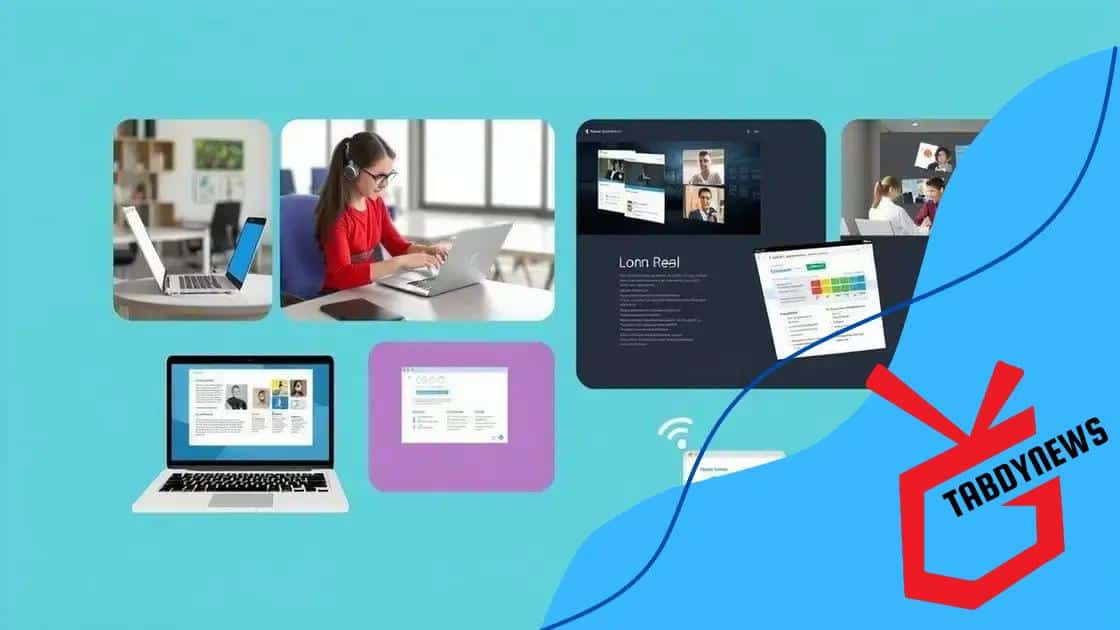The impact of virtual classrooms on student collaboration

The impact of virtual classrooms on student collaboration is profound, enhancing engagement, enabling real-time communication, and fostering diverse learning experiences through advanced technologies.
The impact of virtual classrooms on student collaboration is significant, inviting us to rethink traditional learning. How do these digital spaces shape teamwork among students? Let’s dive into this fascinating topic!
Understanding virtual classrooms
In today’s educational landscape, understanding virtual classrooms is essential. These digital environments have transformed how students learn and collaborate. Unlike traditional classrooms, virtual classrooms utilize technology to bring students together, regardless of their physical locations.
What are virtual classrooms? They are online platforms that facilitate learning through video conferencing, discussions, and shared resources. In these settings, students can interact with teachers and peers in real-time, making learning flexible and engaging.
Key Features of Virtual Classrooms
Some key features that enhance the learning experience include:
- Real-time interaction: Students can ask questions and receive immediate feedback.
- Access to resources: Learning materials are often available at the click of a button.
- Collaboration tools: Features like breakout rooms allow for group work and discussions.
The integration of tools like chat functions, discussion boards, and document sharing promotes a sense of community. But it’s not just about technology; virtual classrooms encourage critical thinking and problem-solving skills. Students are required to engage actively, fostering a collaborative environment.
Benefits of Understanding Virtual Classrooms
Understanding virtual classrooms also comes with great benefits:
- Flexibility: Learning can occur anytime and anywhere, which helps students balance their studies with other commitments.
- Diverse learning styles: Different tools and resources cater to various preferences, enhancing the learning experience.
- Global reach: Students can connect and work with peers from different parts of the world.
As we look at the benefits, it becomes clear that the impact of virtual classrooms extends beyond mere convenience. They are reshaping the educational experience by breaking barriers and fostering collaboration.
Benefits of student collaboration in virtual settings
Virtual settings have significantly changed how students collaborate. This collaboration is essential because it enhances learning experiences and builds important skills. In these digital environments, students can work together seamlessly, even when they are miles apart.
One major benefit of student collaboration in virtual settings is increased engagement. When students collaborate, they are more likely to participate actively. This environment encourages them to express their ideas and share knowledge with their peers. As they collaborate, students also develop essential social skills.
Key Advantages of Collaboration
Let’s explore some key advantages:
- Diverse perspectives: Students bring different backgrounds and ideas to the table, enriching the learning process.
- Improved communication: Working together helps students articulate their thoughts clearly and listen to others.
- Shared resources: Students can access various digital tools and materials that enhance their learning experiences.
Furthermore, student collaboration leads to stronger problem-solving abilities. As students tackle challenges together, they learn to brainstorm and discuss various solutions. This promotes critical thinking as they evaluate different options and make decisions collaboratively.
Building Community and Connections
Another vital aspect is the sense of community that develops. Students who collaborate online often form lasting friendships and professional networks. Through collaborative projects, they can build connections that will benefit them in the future.
Finally, the flexibility of virtual collaboration allows students to work on their schedules. They can meet at times that suit them best, making it easier for everyone to contribute. This flexibility supports different learning styles and paces, making education more inclusive.
Technologies facilitating collaboration

Various technologies play a crucial role in facilitating collaboration among students in virtual classrooms. These tools enhance communication and teamwork, making learning more engaging and effective. Embracing these technologies helps students develop essential skills that they will use throughout their lives.
One important category of tools is video conferencing software. Applications like Zoom and Microsoft Teams allow students to connect in real time. With video, students can see each other and share their screens, making discussions more interactive.
Collaboration Tools
In addition to video conferencing, several other technologies support collaboration:
- Document sharing platforms: Tools like Google Docs enable students to work on projects simultaneously. They can edit documents, leave comments, and view changes in real-time.
- Project management apps: Platforms like Trello and Asana help students organize tasks and track progress. These tools allow them to set deadlines, assign responsibilities, and ensure everyone stays on track.
- Instant messaging services: Chat tools such as Slack foster quick communication among group members. Students can create specific channels for different topics, which helps keep conversations organized.
Moreover, learning management systems (LMS) like Canvas and Moodle provide a centralized space for students to access course materials and collaborate. These systems often include forums and discussion boards where students can post questions and share ideas in a supportive environment.
Enhancing Learning Experiences
Utilizing these technologies not only makes collaboration easier but also enhances the overall learning experience. Students can explore different mediums, work together creatively, and support each other’s learning journeys. As they navigate these tools, they build digital literacy skills that will be invaluable in their future careers.
Ultimately, the integration of technology in virtual classrooms demonstrates that collaborative learning can thrive even in a digital environment. By leveraging these tools, students can continue to engage meaningfully while developing strong teamwork skills.
Challenges in virtual student interactions
Engaging in virtual student interactions comes with its own set of challenges. While technology has made learning more accessible, it also presents obstacles that can affect collaboration and communication among students. Understanding these challenges is essential for improving online learning experiences.
One significant issue is the lack of physical presence. In traditional classrooms, students can read body language and non-verbal cues. In virtual settings, these cues may be lost, leading to misunderstandings. Students may find it harder to gauge their peers’ reactions during discussions, which can hinder effective communication.
Common Challenges
Some common challenges students face include:
- Technical issues: Connectivity problems, software glitches, and inadequate hardware can disrupt learning and collaboration.
- Distraction: Being in a non-traditional learning environment can lead to distractions, making it difficult for students to focus during collaborative activities.
- Time zone differences: For online classes with international participants, scheduling collaborative sessions can be tricky due to varying time zones.
In addition to these challenges, students might feel isolated in virtual classrooms. Without face-to-face interaction, building a sense of community can be difficult. This isolation can lead to decreased motivation and engagement. As students engage with peers online, they may struggle to form the relationships that are often fostered through shared physical spaces.
Overcoming Interaction Barriers
To overcome these challenges, it is important to implement strategies designed to enhance interactions. For instance, setting clear communication guidelines can help students understand when and how to engage effectively. Regular check-ins can also provide opportunities for students to express concerns and encourage peer-to-peer support.
Using interactive tools such as polls or breakout rooms in virtual classrooms can facilitate more engaging discussions. These strategies help to recreate some of the collaborative atmosphere typical of in-person learning environments.
Future trends in virtual education
The future of virtual education is bright, with many exciting trends shaping how we learn and collaborate online. As schools and universities continue to adapt, students can expect more innovative methods of learning that enhance their educational experiences. One of the emerging trends is the use of artificial intelligence in education.
AI technology can help personalize learning by analyzing each student’s strengths and weaknesses. This enables educators to tailor their teaching strategies to meet individual needs. With AI tools, students can receive instant feedback on their work, helping them improve continuously.
Increased Accessibility
Another trend is the focus on accessibility. Educational institutions are increasingly investing in technologies that make learning more inclusive for everyone, including those with disabilities. Adaptive learning technologies are being developed to provide customized resources based on individual learning styles.
- Virtual Reality (VR): VR allows students to immerse themselves in different environments and experiences, making learning more engaging.
- Augmented Reality (AR): AR technology can enhance real-world learning by overlaying digital information onto physical spaces.
- Collaborative learning platforms: These platforms are designed to facilitate teamwork among students from various locations.
The integration of blockchain technology is another exciting trend in virtual education. Blockchain can enhance the security and transparency of educational records. By providing a secure way to verify credentials, students can have greater confidence in the value of their qualifications.
Focus on Lifelong Learning
As the world changes rapidly, there’s an increasing emphasis on lifelong learning. Online courses and certification programs are becoming more popular, allowing individuals to continue their education beyond traditional schooling. This flexibility empowers learners to adapt to new job markets and technologies.
The future of virtual education seems to be leading toward a more interconnected world. With the right technologies and methods in place, students will have access to enriched learning experiences that support their personal and professional growth.
FAQ – Frequently Asked Questions about Virtual Classrooms and Student Collaboration
What are the advantages of virtual classrooms for student collaboration?
Virtual classrooms provide flexibility, accessibility, and diverse resources that enhance collaboration among students, encouraging active participation.
How can technology improve student interactions in virtual settings?
Technology such as chat tools, video conferencing, and collaborative platforms helps students communicate effectively and work together in real time.
What challenges do students face in virtual classrooms?
Students may encounter issues like technical difficulties, distractions, and a lack of physical presence, which can hinder effective communication and collaboration.
What future trends can we expect in virtual education?
We can expect increased use of AI for personalized learning, enhanced accessibility, and a focus on lifelong learning opportunities for students.





